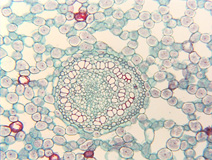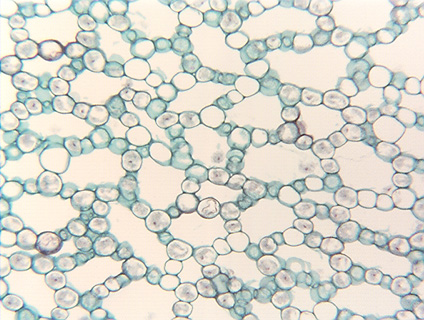

Fig. 3.3-5 a and b. Transverse section of sweet flag (Acorus) rhizome. Rhizomes of Acorus are thick and grow horizontally through mud, so having a light-weight structure is not especially advantageous from a support stand point, but their aerenchymatous construction allows oxygen diffusion down to the rhizome from the leaves (the mud of marshes is low in oxygen because abundant bacteria use it in their respiration). Whereas the stems of Scirpus (Fig. 3.3-3) and Juncus (Fig. 3.3-4) have thick plates of cells separating air canals, this stem of Acorus has plates only one parenchyma cell thick. Think of how little material is used by Acorus in the growth of these stems: most stem volume is air, and the part that is cellular consists of thin primary walls, large vacuoles (mostly just water), and only a thin film of cytosol with organelles like mitochondria, endoplasmic reticulum and nuclei. If all air and water were removed from this stem, almost nothing would remain. Notice there is no debris between the plates of cells – these intercellular spaces formed as the middle lamella broke down and neighboring cells were pulled away from each other, all cells remaining alive, none being torn apart (schizogenous formation of intercellular spaces; see pages 149-152 in Plant Anatomy (Mauseth)).